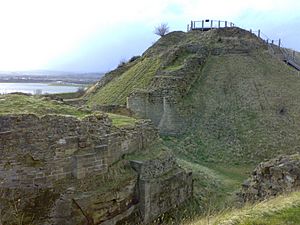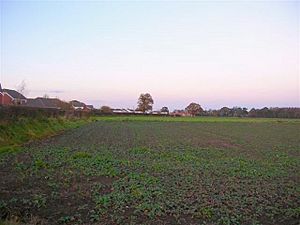Thomas Neville (died 1460) facts for kids
Quick facts for kids
Thomas Neville
|
|
|---|---|
| Born | c. 1429 |
| Died | 30 December 1460 (aged c. 31) Sandal Magna, Yorkshire, England |
| Buried | Bisham Abbey, Berkshire |
| Family | Neville |
| Spouse(s) | Maud Stanhope (1453–1460, widowed) |
| Father | Richard Neville, 5th Earl of Salisbury |
| Mother | Alice Montagu, 5th Countess of Salisbury |
Sir Thomas Neville (around 1429 – 1460) was an important English nobleman. He was the second son of Richard Neville, 5th Earl of Salisbury, a very powerful lord in northern England. His older brother was the famous Richard Neville, Earl of Warwick, known as the 'Kingmaker'.
Thomas worked closely with his father and brother. He helped them manage the northern region for the King. He became a key player in the exciting and sometimes dangerous politics of northern England in the early 1450s. This was especially true in the growing rivalry between his family, the Nevilles, and another powerful family, the House of Percy.
His wedding in August 1453 is often seen as the start of a big fight between the Nevilles and the Percys. Thomas and his brother John led many attacks and small battles across Yorkshire against the Percy family. Historians say this feud helped set the stage for the Wars of the Roses. This was a huge war between two families, the Lancaster and York, who were fighting for the English throne. Thomas played a big part in the Neville family's alliance with his uncle, Richard, Duke of York, who led the Yorkist side.
Thomas fought in his father's battles. He was at the Battle of Blore Heath in September 1459. There, he and his younger brother John were captured by the Lancastrians. Because of this, he was put in prison. He was also declared a traitor, along with his father, brothers, and other Yorkists, at a special meeting of Parliament in 1459. Since he was in prison, he didn't go into exile in Calais like his father and Warwick.
However, when Warwick and the future Edward IV returned the next year, Thomas was set free. This happened after they won the Battle of Northampton. When the Duke of York also returned and tried to claim the throne from Henry VI, Thomas was the one who told the Duke that the Nevilles didn't agree with his plan.
In December 1460, Thomas joined his father Salisbury and the Duke of York's army. They went to Yorkshire to stop some trouble caused by the Lancastrians. He took part in the terrible Battle of Wakefield. The Yorkists lost badly. Thomas was killed in the fight. His head, along with his father's and uncle's, was put on display above one of the gates of the city of York.
Template:TOC limit=3
Thomas Neville's Early Life and Marriage
Thomas Neville was the second son of Richard Neville, 5th Earl of Salisbury (1400–1460) and his wife Alice Montagu, 5th Countess of Salisbury (around 1406–1462). He was likely born soon after his older brother Richard Neville, Earl of Warwick in 1428. Historian Michael Hicks says that by this time, his parents had two more sons after Thomas: John and George, who later became a church leader.
Thomas is first mentioned in government records in 1448. He was made a steward for the Bishopric of Durham by his uncle, Bishop Robert Neville. He received money each year for this job. On March 24, 1450, he became the Sheriff of Glamorgan. In this role, he witnessed an important document for his brother, Warwick the 'Kingmaker', in March 1451. Warwick also asked Thomas to help manage his lands in Warwickshire and gave him a yearly payment.
King Henry VI made Thomas Neville a knight on January 5, 1453, in the Tower of London. This happened at the same time as the King's two half-brothers, Edmund and Jasper Tudor, were also knighted. This event was seen as an attempt by the King to keep the Neville family loyal.
On May 1, 1453, the King gave Thomas Neville permission to marry Maud Stanhope. Maud was the widow of Robert, Lord Willoughby, and she was a very rich heiress. Some historians believe that the announcement of Thomas's marriage was the direct cause of the feud with the Percys. Maud was also the niece and co-heiress of Ralph, Lord Cromwell, who was one of the wealthiest men in England. Lord Cromwell was involved in fights with other powerful men at this time. Marrying his family into the Nevilles was a way for Cromwell to get help against his enemies. This marriage cost the Nevilles a huge amount of money in loans to Salisbury. It showed how desperate Cromwell was for their support. This marriage not only upset the Percys because it made the Nevilles even stronger, but it also gave the Nevilles access to lands that the Percys had once owned.
Fighting the Percy Family
The Nevilles were one of the four main landowning families in the north of England. The others were Richard, 3rd Duke of York, the King (who owned lands as the Duke of Lancaster), and the Percy family, who were the earls of Northumberland. Since the Duke of York and the King were often away, most of the tension was between the Percys and the Nevilles.
By 1453, this tension had turned into open violence. Thomas and his brother John actively sought out the younger sons of the Earl of Northumberland. These included the hot-headed Thomas, Lord Egremont, his younger brother Sir Richard Percy, and their followers.
On August 24, 1453, Thomas Neville's wedding party was attacked by Lord Egremont at Heworth, York. This happened as the Nevilles were returning to Yorkshire with Thomas's new wife from Cromwell's Tattershall Castle. The Percy force was said to have 5,000 men. There were more clashes before the Percys were defeated at Stamford Bridge on October 31, 1454. At this battle, Thomas and John Neville ambushed the Percy brothers, Egremont and Sir Richard. They were then imprisoned in Newgate.
Thomas Neville's Final Years
In 1457, Thomas Neville was given an important job as Chamberlain of the Exchequer. He shared this role with another heir of Ralph, Lord Cromwell. Later that year, his father and brother made Thomas their deputy on the West March. This was a border area where they were joint Wardens. For this, he received a salary. A few months later, he promised good behavior for his uncle William, Lord Fauconberg.
By 1459, the political situation in England had become a full-blown civil war. In September, the Earl of Salisbury marched south from his castle at Middleham to join the Duke of York. Thomas marched with him in an army of 5,000 men. On September 23, 1459, they met a larger royal army at Blore Heath. Salisbury defeated this army, killing its leader. However, Thomas and John were captured near Tarporley, Cheshire, the next day. Some historians think they were wounded and sent home. Others believe they went too far from the main army while chasing fleeing Lancastrians.
The next month, they were declared traitors in a special Parliament. They were imprisoned in Chester Castle. They were not released until their brother Warwick won the Battle of Northampton in June 1460. After his release, Thomas Neville was immediately given important tasks. He was appointed, along with his father, to manage the King's stables. This was part of the Nevilles' plan to put their supporters in important political positions. He was also appointed to groups that would arrest anyone disturbing the peace. At the same time, he received land grants from the Duchy of Lancaster.

When the Duke of York joined them and claimed the throne in October 1460, the Nevilles, like other nobles, did not support his claim. Thomas Neville seems to have been key to his father Salisbury's resistance to York's claims. It was Thomas, possibly with Warwick, who met York at Westminster Palace. York had taken over the King's rooms there. Thomas told the Duke that his claim was not supported by "both lords and people." According to one historian, the Archbishop of Canterbury refused to confront the Duke of York. So, on two occasions, "Thomas Neville was sent instead." Two days later, on October 13, 1460, he went to York again. What was said is unknown, but Neville's message must have been very clear and direct. York agreed to a compromise.
Meanwhile, Lancastrian forces were gathering in Yorkshire. They were attacking York's and Salisbury's lands and tenants. Thomas Neville went with them when they marched out of London on December 2, 1460. Their goal was to bring order back to the region. They arrived at York's Sandal Castle on December 21. It's possible a Christmas truce was arranged. However, nine days later, York, his son Edmund, Salisbury, Thomas, and many of their closest followers led an attack. They went out to fight a Lancastrian army gathered near the castle. Here, at the Battle of Wakefield, they suffered a crushing defeat. Thomas died in the fighting. His father was later executed. Their heads were displayed above the gates of York.
Thomas's remains were removed from the Micklegate Bar after the Yorkists won a big victory at the Battle of Towton three months later. He was buried at the Dominican Priory in York. Later, he and his father were reburied with his mother when she died in February 1463, at Bisham Priory.


